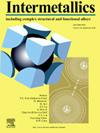Cooling rate effects on microstructure and properties of Al–Cu–Mg–Ag alloys: A comparative study of freeze-casting and resin sand mold casting
IF 4.8
2区 材料科学
Q2 CHEMISTRY, PHYSICAL
引用次数: 0
Abstract
This study sought to overcome mechanical property degradation in sand-cast Al-Cu-Mg-Ag alloys by improving the cooling efficiency through frozen sand mold and freeze-ablation casting. The solid solubility and alloy segregation were controlled by the cooling rate to suppress and refine phases and prevent harmful phase formation. The effective control of cooling rates significantly enhanced solidification characteristics. The cooling rates increased to 1 °C/s in frozen sand mold casting and 14 °C/s in freeze-ablation casting compared to 0.5 °C/s in traditional resin sand mold casting, reducing the grain size from 115 to 60 μm. More rapid cooling improved solid solubility and the equilibrium partition coefficient, effectively reducing micro-segregation. The secondary phase size decreased from 9.1 μm to 2.7 μm, and its content reduced from 10.6 J/g to 5.8 J/g. Under high cooling rates, Sc atoms tend to form a supersaturated solid solution, thereby suppressing the precipitation of Sc-rich phases and inhibiting the nucleation of the W phase. The unique microstructure created by rapid cooling promotes phase redissolution and the precipitation of finely dispersed phases during heat treatment, thereby increasing the alloy tensile strength from 430 MPa to 495 MPa. This study introduces a novel process for developing high-performance cast Al-Cu-Mg-Ag alloys by controlling cooling rates to manipulate the microstructure.
冷却速率对Al-Cu-Mg-Ag合金组织和性能的影响:冷冻铸造与树脂砂型铸造的比较研究
本研究试图通过冷冻砂型和冷冻烧蚀铸造提高冷却效率来克服Al-Cu-Mg-Ag合金的力学性能退化问题。通过冷却速率控制固溶度和合金偏析,抑制和细化相,防止有害相的形成。有效控制冷却速率可显著提高凝固特性。与传统树脂砂型铸造的0.5°C/s相比,冷冻砂型铸造的冷却速度提高到1°C/s,冷冻烧蚀铸造的冷却速度提高到14°C/s,晶粒尺寸从115 μm减小到60 μm。更快速的冷却提高了固体溶解度和平衡分配系数,有效地减少了微偏析。二次相尺寸由9.1 μm减小到2.7 μm,含量由10.6 J/g减小到5.8 J/g。在高冷却速率下,Sc原子容易形成过饱和固溶体,从而抑制富Sc相的析出,抑制W相的形核。快速冷却形成的独特组织促进了热处理过程中相的再溶解和细小分散相的析出,从而使合金的抗拉强度从430 MPa提高到495 MPa。本研究介绍了一种通过控制冷却速度来控制微观组织来制备高性能铸造Al-Cu-Mg-Ag合金的新工艺。
本文章由计算机程序翻译,如有差异,请以英文原文为准。
求助全文
约1分钟内获得全文
求助全文
来源期刊

Intermetallics
工程技术-材料科学:综合
CiteScore
7.80
自引率
9.10%
发文量
291
审稿时长
37 days
期刊介绍:
This journal is a platform for publishing innovative research and overviews for advancing our understanding of the structure, property, and functionality of complex metallic alloys, including intermetallics, metallic glasses, and high entropy alloys.
The journal reports the science and engineering of metallic materials in the following aspects:
Theories and experiments which address the relationship between property and structure in all length scales.
Physical modeling and numerical simulations which provide a comprehensive understanding of experimental observations.
Stimulated methodologies to characterize the structure and chemistry of materials that correlate the properties.
Technological applications resulting from the understanding of property-structure relationship in materials.
Novel and cutting-edge results warranting rapid communication.
The journal also publishes special issues on selected topics and overviews by invitation only.
 求助内容:
求助内容: 应助结果提醒方式:
应助结果提醒方式:


